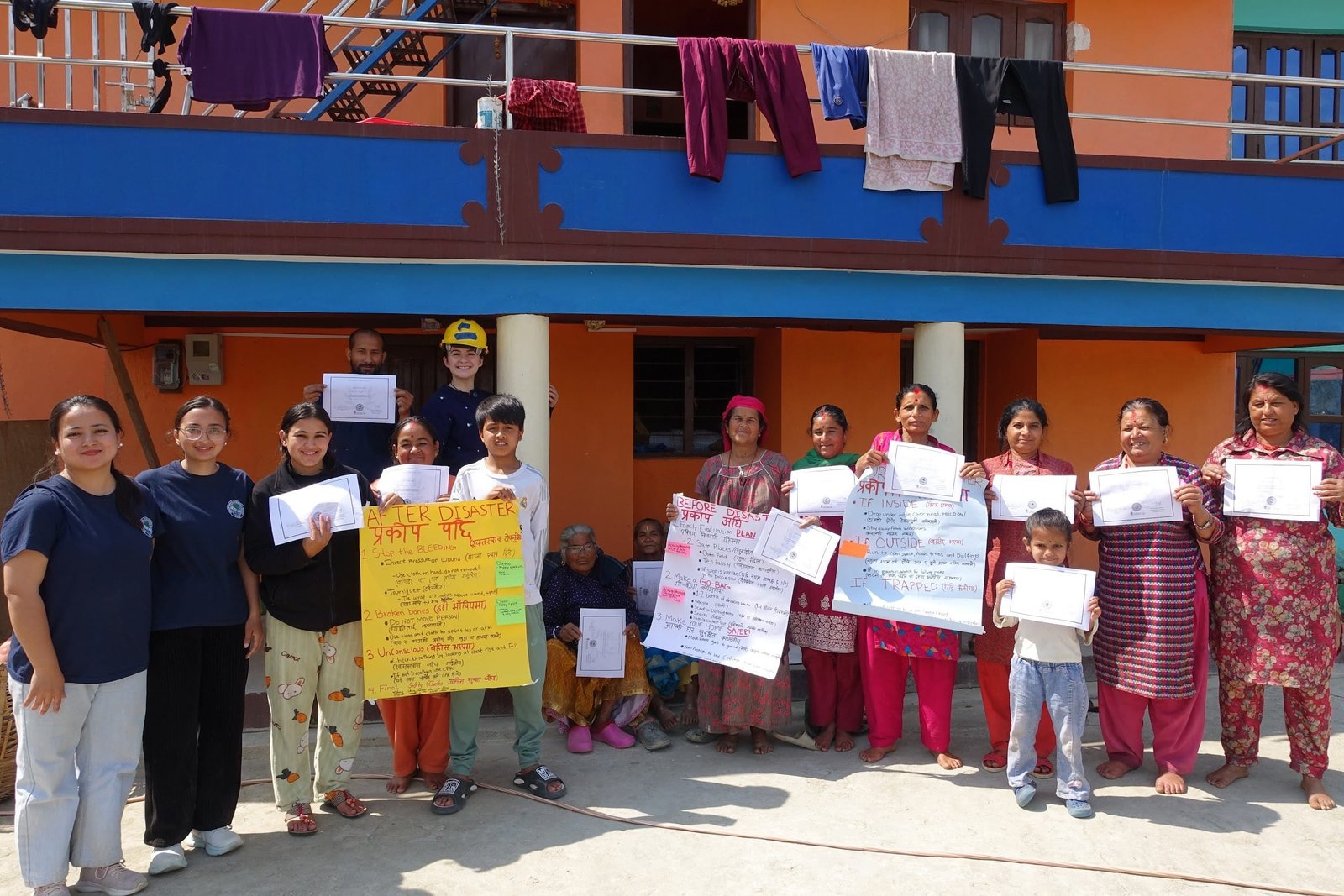written by Berenice BOURRET
Training communities for a safer future
Volunteers Initiative Nepal (VIN) is a nonprofit organization focused on empowering local communities in Nepal through education, health, disaster risk reduction, and women’s empowerment. By providing the necessary tools and knowledge, VIN works alongside these communities to help them overcome challenges and build resilience. With the support of dedicated volunteers, VIN fosters collaboration and creates lasting impact.

A moment of solidarity and shared commitment after the session, captured on March 21, 2025, at the Kishandol community, showcasing the energy and dedication of the participants united in their desire to learn and prepare for future challenges.
Nepal, nestled in the heart of the Himalayas, remains vulnerable to earthquakes. The devastating 2015 disaster, which claimed nearly 9,000 lives and left hundreds of thousands homeless, serves as a stark reminder of the importance of disaster preparedness. While no one can predict when the next earthquake might occur, raising awareness and taking preventive measures can save lives.
With this in mind, Kymber Keaton, a volunteer with Volunteers Initiative Nepal (VIN) under the Disaster Risk Reduction Program, is traveling from community to community to deliver essential training on earthquake safety. Today, our team arrived in Jitpurphedi, a rural village north of Kathmandu, to conduct another session. Her goal: to teach as many people as possible how to prepare for and respond effectively to an earthquake, should another one strike.
A mission with a purpose: Why disaster preparedness matters
For Kymber, disaster risk reduction is more than just a field of study—it’s a mission: « I chose this program because it aligns with my studies, and I am very passionate about disaster risk reduction. I like providing others with the tools to protect themselves. ». Teaching people what to do before, during, and after an earthquake helps them feel more in control and capable of protecting their families.
Women at the forefront: Empowering communities with life-saving knowledge
In many communities in Nepal, women are often the primary caregivers and responsible for managing household safety. In rural areas like Jitpurphedi, they typically bear the responsibility of protecting their children, elderly family members, and managing daily tasks. Therefore, equipping them with disaster preparedness knowledge has a direct and significant impact.
One of the strengths of Kymber’s approach is that her recommendations are simple, cost-free, and immediately applicable: « The tools I teach in this lesson cost nothing and are things the women can implement right away. It empowers them to take care of their families and inspires them to make changes in their homes today. ». From preventive measures to first aid techniques, these training sessions equip communities with the necessary skills to act without relying solely on external aid.
Tailored for reality: Safety tips for earthquake-prone communities
In Jitpurphedi, where homes are often built from bricks and mud, earthquake risks differ from those in other parts of the world. That’s why Kymber’s recommandations take local structures into account: « My main recommendation focuses on cost-free solutions like moving heavy items to the ground to prevent them from falling, creating a go-bag with essentials they already have at home, and, most importantly, planning. Many of these women know they should go outside during and earthquake, but their families don’t always know where exactly ‘outside’ is? ».
2015 Earthquake: A nation’s wake-up call
On April 25, 2015, Nepal experienced one of its deadliest earthquakes, with a magnitude or 7.8. The epicenter was located near Barpak, Gorkha, about 80 km northwest of Kathmandu. The disaster caused massive destruction:
- Nearly 9,000 people lost their lives, and over 22,000 were injured.
- Hundreds of thousands of homes were reduced to rubble, particularly in rural areas where buildings were not earthquake-resistant.
- UNESCO heritage sites, including temples in Kathmandu Durbar Square, Patan, and Bhaktapur, were severely damaged or destroyed.
- The earthquake triggered landslides and avalanches, including one on Mount Everest, which killed 22 climbers and Sherpas.
- A powerful 7.3 aftershock on May 12 further worsened the situation. The entire nation was left in shock, and millions of people were displaced, forced to live in temporary shelters for months.
Why Nepal suffers: The deadly consequences of poor preparation
Nepal lies to the collision zone of the Indian and Eurasian tectonic plates, making it highly earthquake-prone. The 2015 disaster exposed major vulnerabilities, including:
- Weak building structures that were not designed to withstand earthquakes.
- A lack of public awareness and preparedness, leading to panic and disorganized evacuations.
- Difficult terrain and poor infrastructure, which made rescue efforts slow and challenging.
The tragedy became a wake-up call, pushing Nepal to prioritize disaster education and preparedness—the very reason why training sessions like Kymber’s are now essential.
The impact: How communities are changing their approach to safety
The women of Jitpurphedi welcomed the training with enthusiasm and were eager to apply what they had learned immediately: « It was a very good presentation. Useful. We are going to prepare a go-bag today with family contacts, water, snacks, and a scarf or cloth. It’s like a reminder, and we really appreciate it. ». Regularly reinforcing these lessons helps maintain awareness, Even in a region accustomed to frequent tremors.
Learning and forgetting: Overcoming the challenge of retention
While these training sessions are invaluable, a recurring issue remains: people tend to forget what they have learned over time. « We often have these training sessions, but we forget anything once we go back home… »
Since Nepal experiences earthquakes regularly—sometimes monthly—ongoing education and reminders are crucial.
Looking ahead: How preparedness will save lives in the future
For many participants, the 2015 earthquakes was a traumatic expérience, but this session introduced new potentially life-saving techniques: « In 2015, we managed to get out of the house, but we didn’t know what else to do. Today, we learned new things like CPR, injury treatment, and using a whistle to signal if trapped under rubble. We feel safer and we are going to plan more. »




